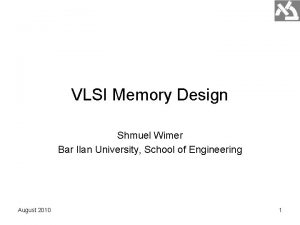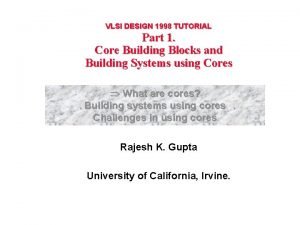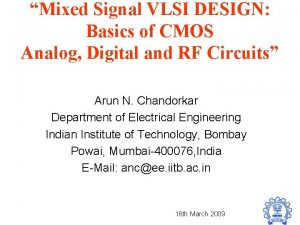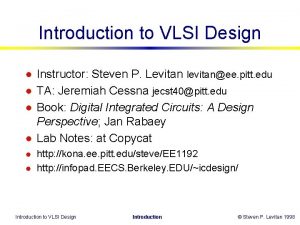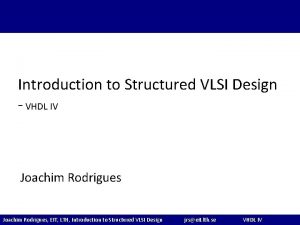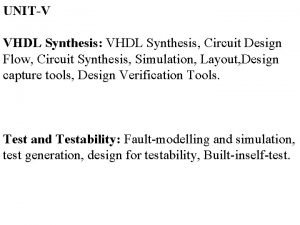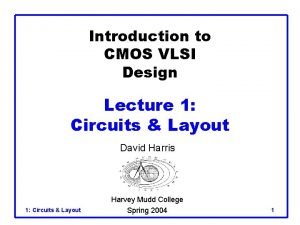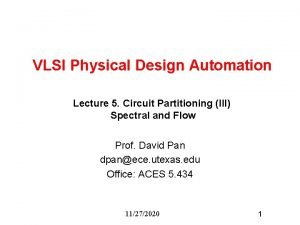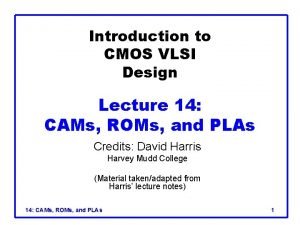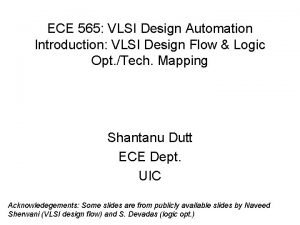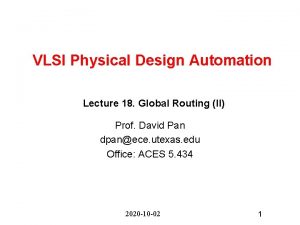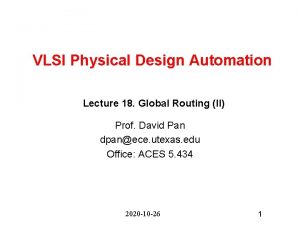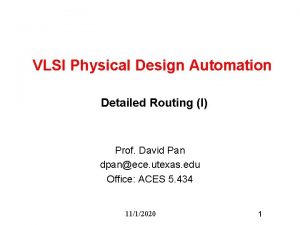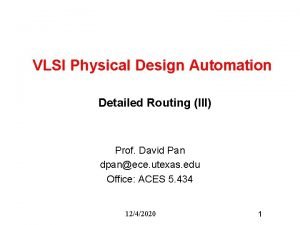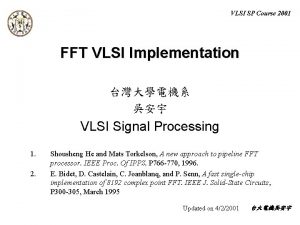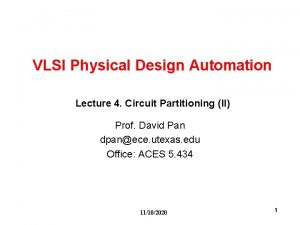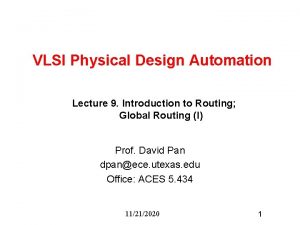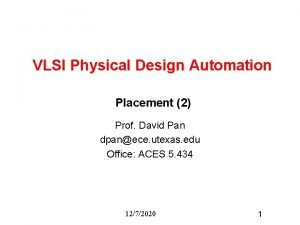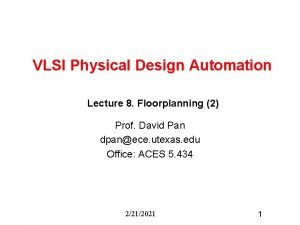VLSI Physical Design Automation Clock and Power Routing






























- Slides: 30

VLSI Physical Design Automation Clock and Power Routing Prof. David Pan dpan@ece. utexas. edu Office: ACES 5. 434 1

Routing of Clock and Power Nets • Different from other signal nets, clock and power are special routing problems – For clock nets, need to consider clock skew as well as delay. – For power nets, need to consider current density (IR drop) • => specialized routers for these nets. • Automatic tools for ASICs • Often manually routed and optimized for microprocessors, with help from automatic tools 2

Clock Introduction • For synchronized designs, data transfer between functional elements are synchronized by clock signals • Clock signal are generated externally (e. g. , by PLL) • Clock period equation td : tskew: tsu: tds: Longest path through combinational logic Clock skew Setup time of the synchronizing elements Propagation delay within the synchronizing element 3

Clock Skew • Clock skew is the maximum difference in the arrival time of a clock signal at two different components. • Clock skew forces designers to use a large time period between clock pulses. This makes the system slower. • So, in addition to other objectives, clock skew should be minimized during clock routing. 4

Clock Design Problem • What are the main concerns for clock design? • Skew – No. 1 concern for clock networks – For increased clock frequency, skew may contribute over 10% of the system cycle time • Power – very important, as clock is a major power consumer! – It switches at every clock cycle! • Noise – Clock is often a very strong aggressor – May need shielding • Delay – Not really important – But slew rate is important (sharp transition) 5

The Clock Routing Problem • Given a source and n sinks. • Connect all sinks to the source by an interconnect network (tree or non-tree) so as to minimize: – – Clock Skew = maxi, j |ti - tj| Delay = maxi ti Total wirelength Noise and coupling effect 6

Clock Design Considerations • Clock signal is global in nature, so clock nets are usually very big – Significant interconnect capacitance and resistance • So what are the techniques? – Routing • Clock tree versus clock mesh (non-tree or grid) • Balance skew and total wire length – Buffer insertion // will be covered in EE 382 V (Optimization issues in VLSI CAD) • Clock buffers to reduce clock skew, delay, and distortion in waveform. – Wire sizing // will be covered in Opt. Issues in VLSI CAD • To further tune the clock tree/mesh 7

Clock trees • A path from the clock source to clock sinks Clock Source FF FF FF 8

Clock trees • A path from the clock source to clock sinks Clock Source FF FF FF 9

H-Tree Clock Routing Tapping Point 4 Points 16 Points 10

H-tree Algorithm • Minimize skew by making interconnections to subunits equal in length – Regular pattern – The skew is 0 assuming delay is directly proportional to wirelength • Is this always the case? ? ? • Can be used when terminals are evenly distributed – However, this is never the case in practice (due to blockage, and so on) – So strict (pure) H-trees are rarely used – However, still popular for top-level clock network design – Cons: too costly to be used everywhere Can you think of another shape if non-rectilinear wires are allowed? 11

Method of Means and Medians (MMM) • Applicable when the clock terminals are arbitrarily arranged. • Follows a strategy very similar to H-Tree. • Recursively partition the terminals into two sets of equal size (median). Then, connect the center of mass of the whole circuit to the centers of mass of the two sub-circuits (mean). • Clock skew is only minimized heuristically. The resulting tree may not have zero-skew. 12

An Example of MMM centers of mass 13

Geometric Matching Algorithm (GMA) • MMM is a top-down algorithm, but GMA is a bottom-up algorithm. • Geometric matching of n endpoints: – Construct a set of n/2 line segments connecting n endpoints pairwise. – No two line segments share an endpoint. – The cost is the sum of the edge lengths. • The basic idea is to find a minimum cost geometric matching recursively. • Time complexity is O(n 2. 5 log n) for n endpoints. 14

An Example of GMA Tapping point (not necessarily the mid-point) H-flipping Apply geometric Post-processing matching recursively. Can give clock tree of zero skew. 15

An Exact Zero Skew Algorithm • • ICCAD 1991 and TCAD 1993, Ren-Song Tsay A classic paper to manage clock skew Use Elmore delay model to compute delay Guarantee zero skew – Can easily to extended for zero skew or bounded skew – Can you think of a method to do it? • Try to minimize wire length, but not done very well – Lots of follow up works to minimize total wire length while maintaining zero skew – DME and its extensions 16

Deferred Merge Embedding • As its name implies, DME defers the merging as late as possible, to make sure minimal wire length cost for merging • Independently proposed by several groups – Edahiro, NEC Res Dev, 1991 – Chao et al, DAC’ 92 – Boese and Kahng, ASIC’ 92 • DME needs an abstract routing topology as the input • It has a bottom-up phase followed by a top-down process (sounds familiar? ) 17

DME: 18

Some Thoughts/Trend • Clock skew scheduling together with clock tree synthesis – Schedule the timing slack of a circuit to the individual registers for optimal performance and as a second criteria to increase the robustness of the implementation w. r. t. process variation. • Variability is a major nanometer concern • Non-tree clock networks for variation-tolerance – How to analyze it? – The task is to investigate a combined optimization such that clock skew variability is reduced with minimum wirelength penalty 19

Non-tree: Spine & Mesh Spines Clock sinks or local sub-networks [Su et. al, ICCAD’ 01] Clock sinks or local sub-networks Applied in Pentium processor [Kurd et. al. JSSC’ 01] Applied in IBM microprocessor t Very effective, huge wire Clock sinks or local sub-networks [Restle et. al, JSSC’ 01] 20

Non-tree: Link Perspective • • Non-tree = tree + links How to select link pairs is the key problem Link = link_capacitors + link_resistor Key issue: find the best links that can help the skew variation reduction the most! i u C/2 u Rl w u C/2 Rl C/2 w [Rajaram et al, DAC’ 04] 21

Power Distribution/Routing 22

Power Distribution • Power Distribution Network functions – – – – Carry current from pads to transistors on chip Maintain stable voltage with low noise Provide average and peak power demands Provide current return paths for signals Avoid electromigration & self-heating wearout Consume little chip area and wire Easy to lay out 23

Power and Ground Routing • Each standard cell or macro has power and ground signals, i. e. , Vdd (power) and GND (ground) • They need to be connected as well • You can imagine that they are HUGE NETWORKS! • In general, P/G routings are pretty regular • They have high priority as well – P/G routing resources are usually reserved – When you do global and detailed routing for signal nets, you cannot use up all the routing resources at each metal layers • Normally some design rules will be given (e. g. , 40% of top metal layers are reserved for P/G) 24

P/G Routing Main Objectives • Routing resource – Need to balance the routing resource for P/G, clock and signals • Voltage drop – – Static (IR) and dynamic (L di/dt) voltage drops More voltage drop means more gate delay Usually less than 5 -10% voltage drop is allowed So you may need to size P/G wires accordingly • Electrical migration – Too big current may cause EMI problem • Others… 25

P/G Mesh (Grid Distribution) • Power/Ground mesh will allow multiple paths from P/G sources to destinations – Less series resistance – Hierarchical power and ground meshes from upper metal layers to lower metal layers • All the way to M 1 or M 2 (stand cells) – Connection of lower layout/cells to the grid is through vias 26

Using One Metal Layer One tree for VDD and another tree for GND. VDD GND 27

Using Two Metal Layers One 2 D-grid for VDD and another one for GND: VDD GND M 5 M 4 28

Gate Array & Standard Cell Design Inter-weaved combs: VDD GND 29

Some Thoughts/Trends • P/G I/O pad co-optimization with classic physical design • Decoupling capacitor can reduce P/G related voltage drop – Need to be planned together with floorplanning and placement • Multiple voltage/frequency islands make the P/G problem and clock distributions more challenging 30
 Power routing in vlsi
Power routing in vlsi Vlsi physical design automation
Vlsi physical design automation River routing and reservoir routing
River routing and reservoir routing Mark tinka
Mark tinka Hydrologic continuity equation
Hydrologic continuity equation Channel routing in vlsi
Channel routing in vlsi Fast clock to slow clock synchronization
Fast clock to slow clock synchronization Why one minute has 60 seconds
Why one minute has 60 seconds Ac power formula
Ac power formula Memory design in vlsi
Memory design in vlsi Y chart in vlsi design
Y chart in vlsi design Vlsi design tutorial
Vlsi design tutorial Subsystem design in vlsi notes
Subsystem design in vlsi notes Mixed signal vlsi design
Mixed signal vlsi design Vlsi
Vlsi Intro to vlsi
Intro to vlsi Y chart in vlsi
Y chart in vlsi Cmos layout design rules
Cmos layout design rules Regularity in vlsi design is defined as
Regularity in vlsi design is defined as Ad hoc testable design techniques
Ad hoc testable design techniques Introduction to vlsi design
Introduction to vlsi design Structured vlsi design
Structured vlsi design Vlsi design styles
Vlsi design styles Design flow of vlsi system
Design flow of vlsi system Vlsi design flow
Vlsi design flow O3ai gate
O3ai gate åq
åq Cmos vlsi design lecture notes
Cmos vlsi design lecture notes Rom design in vlsi
Rom design in vlsi Physical clock
Physical clock Physical clock synchronization in distributed system
Physical clock synchronization in distributed system









